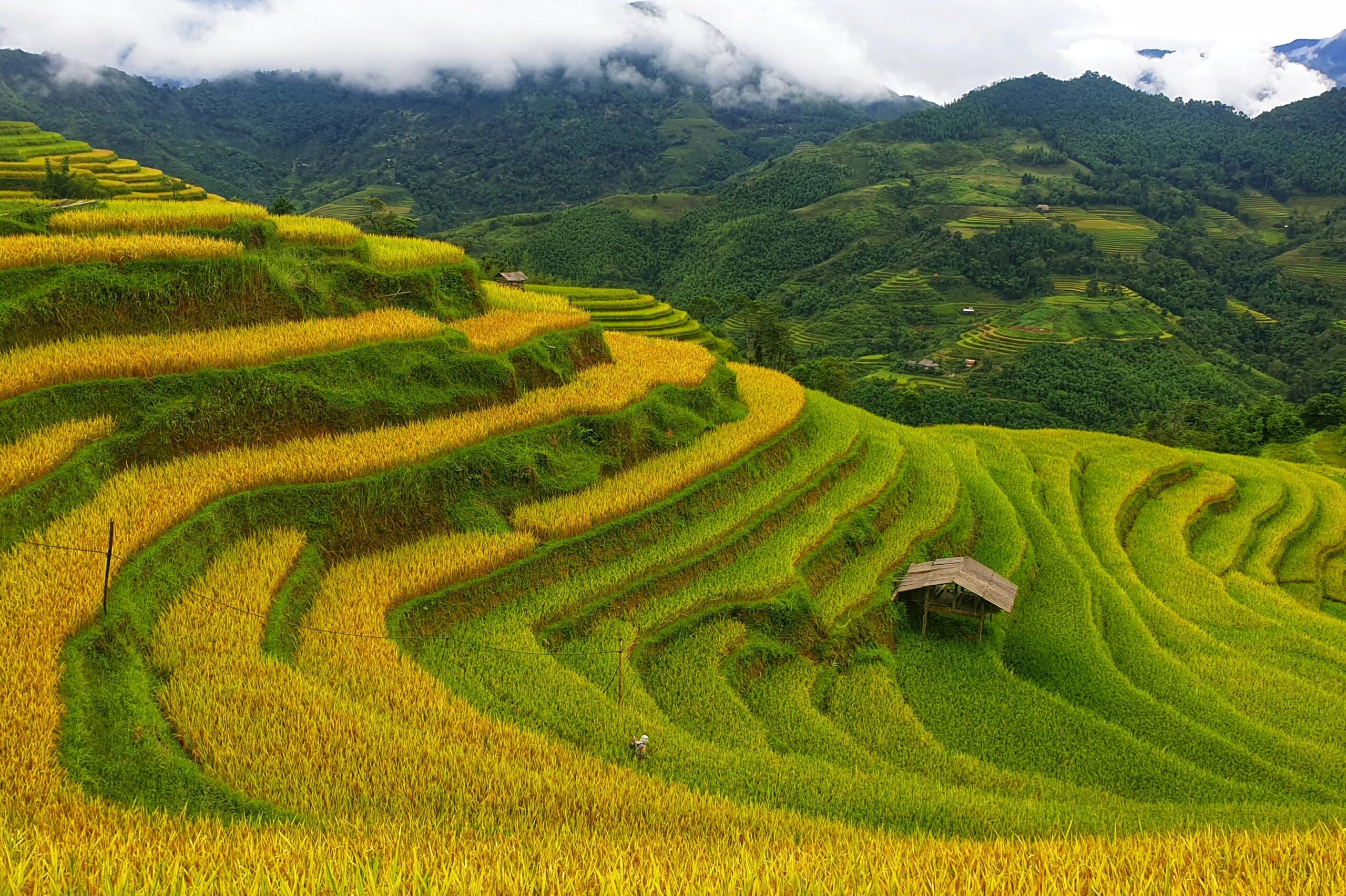Cultivating on Steep Slopes
Step farming, also known as terracing, has been a lifeline for agricultural communities in the Indian Himalayas and other mountainous regions around the world. This ancient practice involves carving the steep slopes of mountains into flat, step-like fields, allowing farmers to cultivate crops in otherwise inhospitable terrain. For centuries, mountain communities have relied on step farming to overcome challenges like rugged landscapes, erratic weather patterns, and limited arable land.
These communities face unique agricultural obstacles, from the threat of soil erosion to inconsistent rainfall. Yet, they have managed to thrive by ingeniously adapting to their environment through step farming. More than just a method of growing food, terracing has become a vital part of the cultural and economic fabric of mountain life. This article explores how step farming not only sustains livelihoods but also preserves local traditions, all while helping these communities face modern challenges like climate change and food insecurity.
A Tradition Rooted in the Mountains: The History of Step Farming in the Himalayas
Step farming has deep historical roots in the Himalayas, stretching back centuries to when indigenous mountain communities first began shaping their rugged environment to meet their agricultural needs. The practice evolved out of necessity, as the steep and uneven slopes made traditional farming impossible. By cutting terraces into the mountainsides, early farmers were able to create flat plots of land that could retain soil and water, making it possible to cultivate a variety of crops.
This technique was not just a matter of agricultural survival but a reflection of the Himalayan communities’ deep connection to their land. Over the generations, step farming became an integral part of the local economy and food systems. The terraced fields not only produced food but also formed a natural irrigation system that conserved water and controlled flooding during monsoon seasons. Crops like rice, maize, and millet, as well as various vegetables, flourished on these terraces, providing vital sustenance for families in these remote areas.
The practice of step farming also played a crucial role in local economies, enabling rural communities to support themselves by growing enough food for both consumption and trade. Today, step farming remains a symbol of resilience and innovation, passed down through generations as a cornerstone of life in the mountains.
The Mechanics of Step Farming: Turning Slopes into Fields
Step farming is a brilliant adaptation to mountainous environments, transforming steep, unworkable slopes into productive farmland. The process begins with the creation of terraces, where horizontal platforms are cut into the mountainside to form flat layers. Stone or mud walls are built along the edges of these terraces to prevent soil from being washed away by rain or runoff. These walls also help to retain water, allowing crops to thrive even in arid or drought-prone regions.
Terracing not only makes steep land arable but also plays a key role in water management. By creating step-like fields, water flow can be controlled, preventing the erosion and nutrient loss that would typically occur on sloped ground. Each terrace holds water longer, ensuring that crops receive a steady supply of moisture without the risk of over-flooding during heavy rains. This makes step farming especially effective in areas with inconsistent rainfall or where water conservation is critical.
In addition to the environmental benefits, step farming maximizes the use of limited land resources. It allows farmers to plant a variety of crops on the same slope, using the altitude and differing soil conditions to their advantage. The terraced fields also act as natural barriers against landslides, offering a protective layer to both crops and the surrounding landscape.
Cultural and Social Significance: Step Farming as a Way of Life
Step farming in the Himalayas is not just an agricultural practice; it is deeply embedded in the social and cultural identity of mountain communities. For centuries, terraced fields have shaped not only the landscape but also the lives of the people who depend on them. Step farming is a family affair, with generations working together to maintain the terraces, plant crops, and harvest produce. The cooperation required to sustain these fields fosters a strong sense of community, where each family plays a role in ensuring the land remains fertile and productive.
Throughout the year, local festivals and rituals are often centered around the agricultural calendar. Events like planting and harvesting are celebrated with communal gatherings, prayers, and traditional songs that express gratitude for the land’s bounty. These rituals are more than just cultural expressions; they reinforce the deep spiritual connection the Himalayan people feel toward their environment and the agricultural cycles that sustain their communities.
Women, in particular, play a crucial role in step farming. They are often the primary caretakers of the terraces, responsible for planting, weeding, and harvesting the crops. This close involvement with the land strengthens their role within the household and the community, empowering them as custodians of traditional farming knowledge passed down from their ancestors.
Step farming also strengthens bonds within the community, as neighbors often come together to help each other during planting and harvesting seasons. This shared labor, combined with the communal rituals tied to the land, ensures that the practice of step farming is more than just a means of survival—it is a way of life that enriches the social fabric and fosters a sense of belonging among mountain-dwelling families.
Climate Change and the Modern Challenges Facing Step Farming
Climate change presents new challenges for mountain communities that rely on step farming. Unpredictable rainfall patterns, frequent landslides, and changing growing seasons are disrupting the delicate balance that terraced agriculture depends on. In the Himalayas, farmers have long mastered the art of step farming, but extreme weather events are putting this ancient technique at risk. The terraces, built to control water flow and retain soil, are now being tested by more intense and irregular monsoon rains, which can lead to erosion and crop damage.
Despite the challenges, local farmers are adapting by combining traditional knowledge with modern techniques. Some are experimenting with drought-resistant crop varieties, while others are reinforcing their terraces with stronger materials to combat erosion. Additionally, the timing of planting and harvesting has had to shift to accommodate changing weather patterns. Farmers are now relying on community-driven solutions and government initiatives to better prepare for unpredictable conditions. While step farming has proven to be resilient, the impacts of climate change mean that continued adaptation is necessary to protect crops, maintain soil fertility, and sustain livelihoods in these regions.
Economic Impact: Sustaining Livelihoods Through Step Farming
Step farming remains a vital economic lifeline for mountain communities, providing both sustenance and income. By transforming steep hillsides into productive land, farmers can grow a variety of crops—such as rice, wheat, and vegetables—that not only feed their families but also support local markets. In many Himalayan regions, terraced fields are a cornerstone of the local economy, where surplus produce is sold or traded, helping farmers generate income and support their communities.
In addition to direct agricultural production, step farming has spurred economic opportunities in other areas, such as tourism. Many travelers are drawn to the scenic landscapes of terraced fields, contributing to the local economy through eco-tourism. Governments and NGOs have recognized the importance of step farming and have begun offering financial assistance and modern tools to help farmers sustain this age-old tradition. Access to better technology, such as irrigation systems and weather monitoring, allows farmers to optimize their farming practices, further strengthening their economic resilience.
Step Farming as a Climate-Resilient Agricultural Practice
Step farming offers significant environmental benefits, making it a climate-resilient agricultural practice. One of its greatest strengths is its ability to conserve water and prevent soil erosion. The terraced design allows water to be absorbed more efficiently, reducing runoff and preventing the loss of fertile soil during heavy rains. This is particularly valuable in areas where water scarcity is becoming a growing issue due to erratic weather patterns caused by climate change.
Terracing also contributes to the preservation of biodiversity. By creating microclimates on each terrace, farmers can cultivate a variety of crops, which helps maintain healthy ecosystems and promotes crop diversity. This agricultural technique also plays a crucial role in stabilizing landscapes, reducing the likelihood of landslides, and helping communities adapt to changing environmental conditions.
Successful case studies, such as those in Nepal and India, have shown how step farming can be adapted to modern challenges while maintaining its environmental benefits. By combining traditional terracing methods with modern innovations, these communities are creating more sustainable agricultural systems that can withstand the impacts of climate change, providing a model for other regions to follow.
A Timeless Practice for a Sustainable Future
Step farming, with its deep cultural roots and environmental benefits, remains a vital practice for mountain communities in the Himalayas. It exemplifies how traditional knowledge can provide sustainable solutions to modern challenges, such as climate change and food security. The resilience of these communities, who have preserved step farming for centuries, is a testament to the power of innovation and adaptation.
As the world faces increasing environmental uncertainties, step farming offers a sustainable model for agriculture that respects both the land and the people who depend on it. By supporting and promoting this ancient technique, we can ensure that mountain regions continue to thrive and contribute to global food security in a sustainable and environmentally conscious way.



